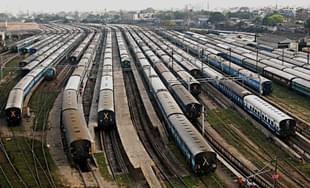Economy
Prabhu’s Image Change Also Includes Passengers
S Murlidharan
Feb 28, 2016, 11:51 AM | Updated 11:51 AM IST
Save & read from anywhere!
Bookmark stories for easy access on any device or the Swarajya app.


Suresh Prabhu’s rail budgets may be a yawn for those looking for grandiose announcements, but lulling music for passengers – especially the old and vulnerable. He doesn’t believe in announcing new trains or stations but believes in making the most of the existing, perhaps heeding the sage advice of Shankaracharya Jayender Saraswati that instead of building new temples we must throng and maintain the existing ones.
Hot milk and hot water
at stations and in trains for toddlers is as comforting to mothers as the 50 percent lower
berths reserved for senior citizens is to them as well as to the family that
anxiously prays for their safe travel.
Deen Dayal coaches and trains targeting the unreserved travelers and
morphing of porters from the demeaning coolies to respectful sahayaks is the railway
minister’s contribution in the direction of image makeover for the government
accused of catering only to the suited and booted category.
And not entirely semantical is the accent on commissioning from completion. Only when a project is ready for use, i.e. commissioned, it is fit to be taken as completed. Who can quarrel with this commercial finery?
Indeed, Prabhu makes it a point to drive home the message that the railways is first and foremost a service provider with a greater customer focus than a manufacturer. He therefore makes all the right noises, including the ones to please gen-next and those who cannot stay away from electronic gadgets for long.
It is not as if all these are empty promises or platitudes. Some of the major stations are indeed looking spic and span with electronic, airport like display systems.
But it is railway economics and financials that might cause a bit of disquiet for those who swear by figures. At 92 percent operating ratio, there is very little room for profits. And the resolve to get back into the freight traffic without concrete here-and-now plans and sans revision down of freight charges with a concomitant revision upwards of passenger fares seems to be a tall talk, though the proposal to constitute a tariff fixing authority does augur well.
Also on the right track is the proposal to reward heavy duty customers of railway freight with long term contracts and insulation from price hikes by means of a scientifically derived and predetermined price escalation formula.
The proposed North-South, East-West and eastern dedicated freight corridors may make railway freight movement faster but they are not going to happen overnight.
That the public sector life insurance behemoth is now cast in the additional role of financier cum face-saver is also a matter of concern. Life Insurance Corporation of India (LIC) comes handy both in avoiding embarrassment for the government in disinvestments as well as in railway financing.
It would be providing a massive Rs 1.5 lakh crore to the railways on attractive terms to the latter, one hopes not at the cost of policyholders. Of course, the central government is the owner of both, thus not throwing up any propriety issues in such freeloading.
Speed figured only marginally and tangentially in the rail budget speech, testifying perhaps to the fact that while comforts figure high in the railway minister’s agenda, safety took a back seat because speed and safety go together. Our tracks must be strong and safe enough to bear high speeds.
But in this day and age, trundling along at a leisurely average speed of 60 kmph doesn’t project our railways as a fast enough mode of transport. While bullet trains are prohibitively expensive, running our trains at the same speed at which they ran in their inaugural runs decades ago virtually catches us in a time warp.





